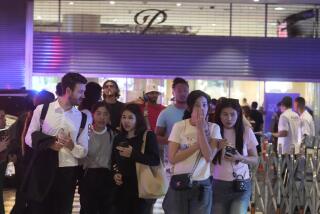Minority Journalists Assail Crime Stories : Media: Blacks at ‘Unity ‘94’ conference say too much of the coverage of African Americans involves crime. Latino portrayals also draw fire.
- Share via
ATLANTA — When Time magazine printed a cover photo last month of America’s most famous murder suspect with his face darkened, black journalists said they clearly saw a powerful message that somehow eluded the white editors who had approved it.
Earl Caldwell, a veteran New York columnist, said: “At Time (magazine), there was not one person of color in the hierarchy to pass on this” darkened photo of O.J. Simpson.
Bruce Johnson, a TV reporter from Washington, said: “If you have some diversity, you are not going to make those kinds of stupid mistakes.”
Los Angeles Police Chief Willie Williams said he was “sickened” to see a recent Newsweek cover that portrayed four members of “Generation X.” Three of the young persons in their 20s were stylishly dressed, but on the left side, with his face darkened, was a young black male wearing a gang-style kerchief.
“Is that typical of African American males? No,” Williams said. “It says to me you should fear my two sons in their 20s, one of whom is a police officer.”
A common complaint heard among black journalists at “Unity ‘94,” a conference of minority journalists here this week, is that African Americans are too often portrayed in the media with a “criminal face.”
This view is shared by black readers and TV viewers as well. A USA Today-Cable News Network poll released this week found that 53% of blacks said members of their race were treated unfairly in local TV coverage of crime. Newspapers did not fare much better, since 47% of blacks were similarly troubled by how their local papers covered crime.
About one-third of Latinos said they believed that Latinos were unfairly portrayed in crime stories.
Although newspapers and magazines came in for their share of criticism, especially regarding photographs, the harshest comments were directed at local television and its near obsession with violence and mayhem. This steady diet of crime stories convinces many viewers, wrongly, that crime is at an all-time high and that whites are likely to become the victims of black criminals, the poll said.
Only a very small number of black people commit crimes, Harvard law professor Charles J. Ogletree Jr. said. “Yet we see so many images of blacks as criminals that it creates the presumption that all blacks are involved in crime.”
The result, he said, is that most black males, even well-dressed professionals, can expect to be stopped by the police and questioned about crime.
FBI statistics show that the rate of violent crimes, such as rapes, robberies, assaults and murders, peaked in 1974 and has fallen 16% since then. But in a survey published in June, Money magazine found 88% of those surveyed believed that crime in America is at an all-time high.
Overall, blacks are three times more likely than whites to be victims of a violent crime. Although black teen-age males are the most likely crime victims, whites over age 65 are the least likely, the FBI data says.
The complaints about crime coverage were certainly not limited to blacks. Melita Garza, an ethnic affairs reporter for the Chicago Tribune, recalled working for a Milwaukee newspaper that ran a headline that said: “Hispanics Half of All Drug Felons.”
She said there were no Latinos in top news positions at the Tribune to question that story. “They would never have thought of doing a story that said ‘99% of white-collar crimes are committed by white males,’ ” she said.
Where blacks find themselves routinely questioned about crimes, Latinos can expect to be stopped by immigration officers, she said. A fellow journalist in Los Angeles had the right approach, she said. When an immigration officer stopped him and asked to see his green card, “he pulled out his American Express card.”
Williams said the media in California have contributed to the belief that Latinos are likely to be illegally in the country.
“There is clearly race-based reporting,” he said. “When you say ‘illegal alien,’ they immediately think ‘Hispanic.’ The second-largest illegal population is Canadians but you can’t pick them out as easily.”
Asian Americans usually do not figure in crime stories, except for the recent wave of “Asian gang” stories, said Vic Lon, a reporter for KRON-TV in San Francisco.
From the media, “you get the idea that Asian American kids are either nerds or in street gangs,” he said.
What can be done to change crime coverage for the better? The minority journalists said news organizations need racial and ethnic diversity in their upper ranks.
More to Read
Sign up for Essential California
The most important California stories and recommendations in your inbox every morning.
You may occasionally receive promotional content from the Los Angeles Times.













